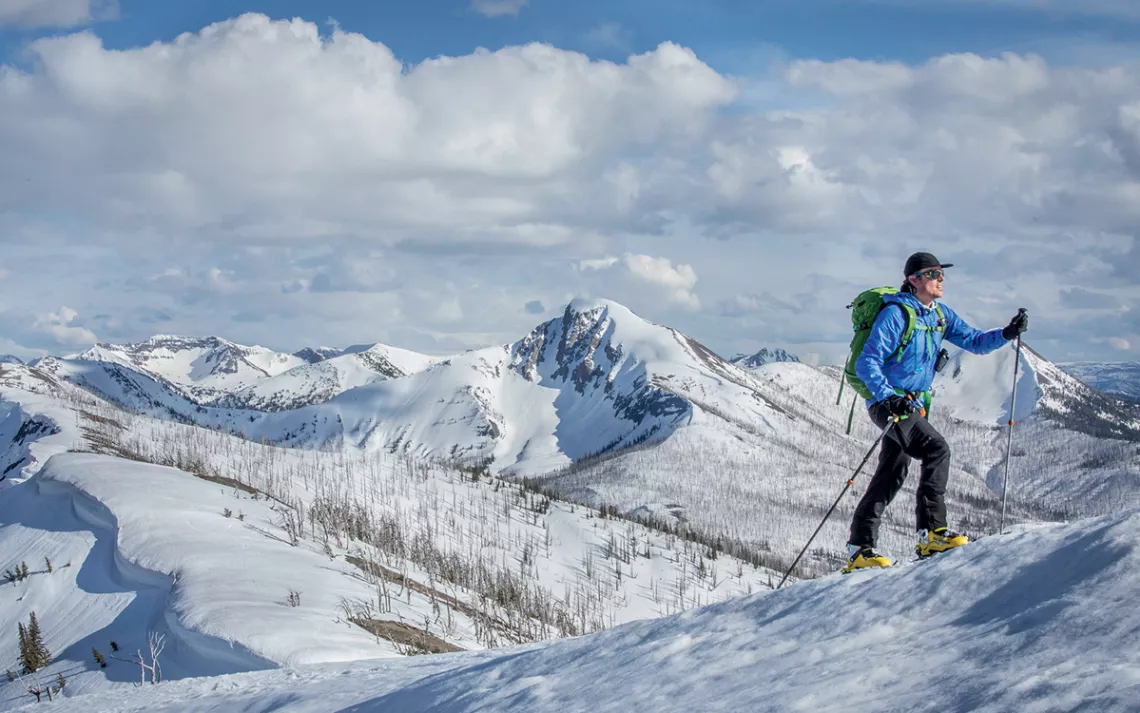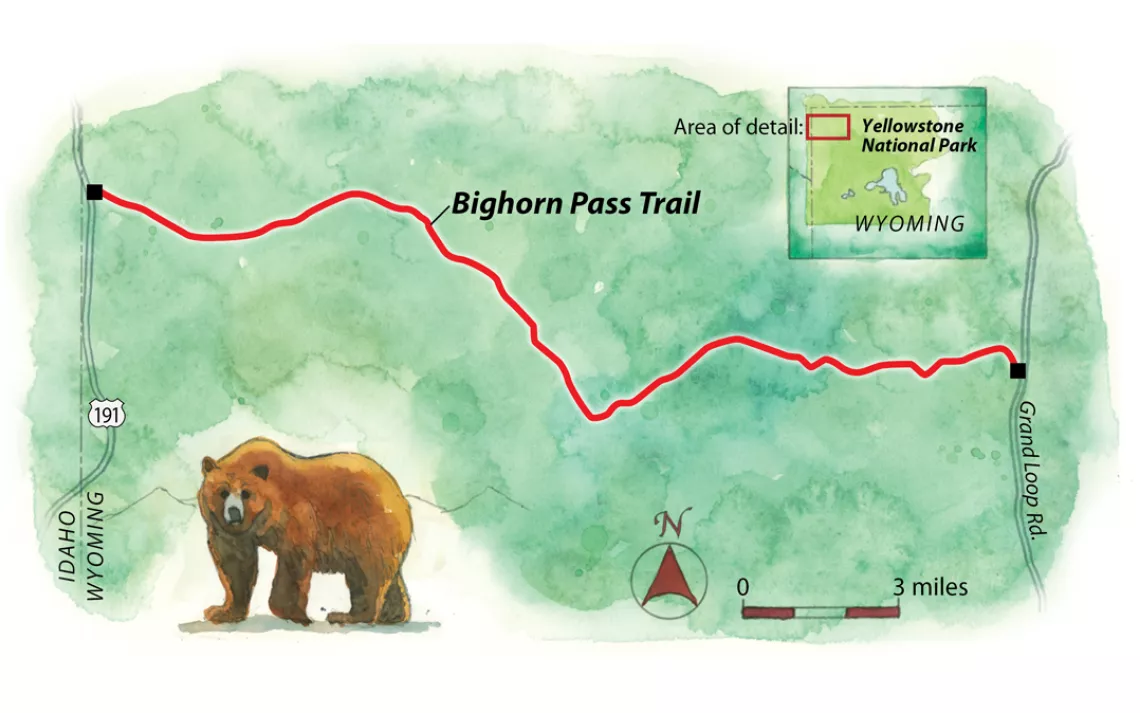A Backcountry Skier Shares Trails With Grizzly Bears in Yellowstone
The country's first national park shows us what coexistence looks like

In the off-season, adventurers share Yellowstone's backcountry with bison, moose, and grizzlies. | Photo by Aaron Teasdale
The sun is low when the grizzly bear appears. I whip my skis sideways and stop. It isn't the first time I've encountered a grizzly while skiing. Actually, this is the fourth one I've seen in the past half hour.
For several minutes, I watch this latest bear root around in the sagebrush flats of Gardner's Hole as the day's last light gilds the northern mountains. It's time I don't have—there's still a creek crossing and a few miles of skiing between me and the park road I must reach before dark. I check my map as the grizzly ambles in the distance and realize that it, too, is heading for Indian Creek. I don't want to surprise the bear at the creek, nor do I want to go too far off course, which would cost precious time and potentially lead to a deeper, more difficult crossing of snowmelt water. If I hope to make it out of here tonight, or ever, I need to get across before the bear.
So I ski. As fast as I can. Until I reach bare ground, where I fumble with bindings, adrenaline pulsing, and start to run with skis in hand. I drop into lower, rolling land where all I can see are the hillsides and the sagebrush surrounding me. Head swiveling constantly, I try to prepare myself for a grizzly bursting toward me at close range.
Ninety-six percent of Yellowstone National Park visitors come between May and October, but winter has long been my favorite season. Though much of the park is inaccessible except by over-snow vehicles, there's an abundance of wild Nordic skiing here, with plowed highways in the western and northern sections delivering access to wildlife-rich landscapes.
My day began shortly after sunrise, at the Bighorn Pass trailhead. My plan was to ski all day, up and over the Gallatin Range at Bighorn Pass and then down the other side to the two-lane Grand Loop Road, where I would thumb a ride 10 miles to the historic Mammoth Hot Springs Hotel and an enormous, indulgent meal.
Skiing here with large mammals—bison, bears, wolves, and moose, among others—can take some getting used to. When I set out, bison had left fresh craters in the snow—reminders to stay alert. The mountains gradually closed in, and the pelvis and spinal cord of some unfortunate animal appeared along the banks of a gin-clear brook. Then, a small trailside sign: "Entering bear management area. No off-trail travel."

Map by Steve Stankiewicz
Yellowstone has 17 bear management areas, designed primarily to protect core grizzly bear habitat at critical times for breeding, feeding, and cub rearing. Many prohibit human entry. Amid an ongoing debate over recreation and conservation, Yellowstone shows us what coexistence looks like.
As I climbed through deep snow, forest gave way to a white alpine world of perfect telemark slopes, corniced ridges, and pyramidal white peaks. I cut a pair of fading bear tracks and scanned the surrounding mountainsides for telltale holes in the drifts left by waking grizzlies. The sun-drenched air was surprisingly still, the sky impossibly blue.
Just before Bighorn Pass, actual bighorn droppings peppered the snow and a peregrine falcon streaked overhead. I considered this good medicine. As was the view, extending across Swan Flats, Bunsen Peak, Blacktail Deer Plateau, and the Lamar Valley to the mighty Absarokas, an alpine wall on the horizon.
Hours later, I emerged into a broad valley a few miles from the road. The forest was unusually quiet. It just felt like bears were there. Sure enough, I entered a large clearing to an unmistakable shape and color in my periphery: the first grizzly, standing 100 yards away. I froze. A second bear appeared, running, and grabbed onto the first. I slid behind a small tree a few feet away from me to observe. As a third bear appeared and loped to the others, I realized: a mother with two yearlings. The breeze was perfect; they didn't smell me. So I sat alone in Yellowstone and watched the mother nurse her young. I wanted to watch them forever, but the sun was sinking all too quickly and I had miles to go.
It's a half hour later when I see the fourth grizzly and start my sprint to the creek. The trail is leading me directly toward this bear, so despite the aforementioned sign, I abandon it, hurtling through the dense shrubs. The creek is deep, but instead of slowing down to assess it, or even to take off my ski boots, I charge in like a wildebeest fleeing a lion. One of wilderness's many benefits is that it teaches us to be humble, to remember we're small figures in a greater community: As ice water surges against my legs, I'm swimming in humility. I harbor no illusions about my place in this world.
Reaching the far bank isn't much relief. It's only when I gain a low rise, get back on my skis, and look back that I properly exhale. Around where I came from, the grizzly roams into view, still rooting around and doing bear things—closer now but unaware of my presence. Just the way it was meant to be.
This article appeared in the November/December 2018 edition with the headline "Bear Racing in Yellowstone."
WHERE Bighorn Pass Trail in Yellowstone National Park
GETTING THERE Access the trailhead from Highway 191 between West Yellowstone and Big Sky. Skiing the ungroomed trail’s first five or so miles, where it shadows the Gallatin River through open terrain, is a popular out-and-back day trip. Other nearby trailheads on the same road offer similar routes, including loop options from Bighorn to the Fawn Pass Trail.
BEST TIME TO VISIT Skiing is typically possible November through April. Grizzlies begin emerging from hibernation in March.
SURVIVAL TIPS Winter can be intensely cold in Yellowstone, so pack extra layers and survival gear. It’s a good idea to have bear spray accessible on all but the coldest midwinter days. Read up on bison behavior and give them and other wildlife a wide berth.
PRO TIPS Freeheel and Wheel in West Yellowstone offers ski rentals and route advice for the region. The Bear Den Ski Shop in Mammoth rents skis for use in the park’s northern reaches—where ungroomed skiing is limitless and several groomed routes lead through spectacular terrain.
MORE bit.ly/bighorn-pass
Take a Sierra Club trip to Yellowstone. Details at sierraclub.org/adventure-travel
 The Magazine of The Sierra Club
The Magazine of The Sierra Club



